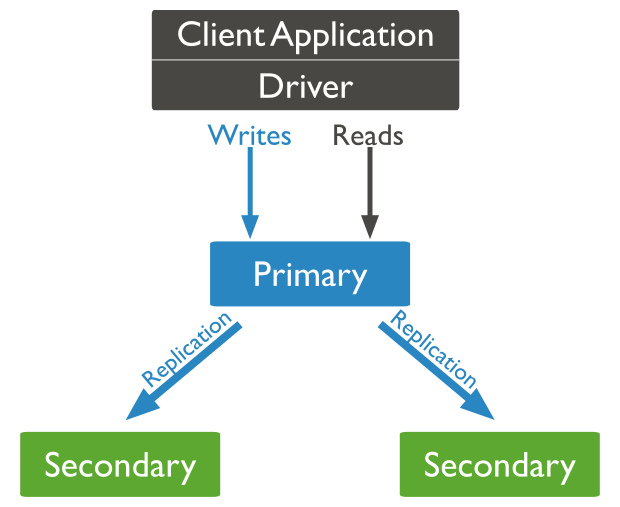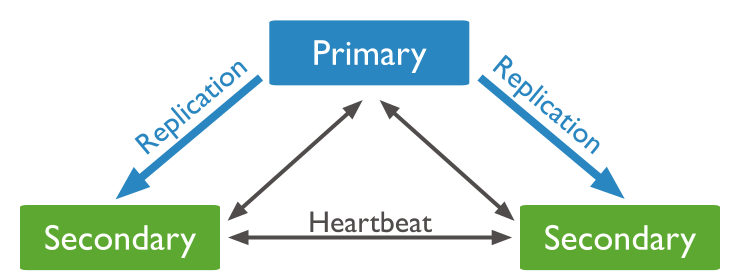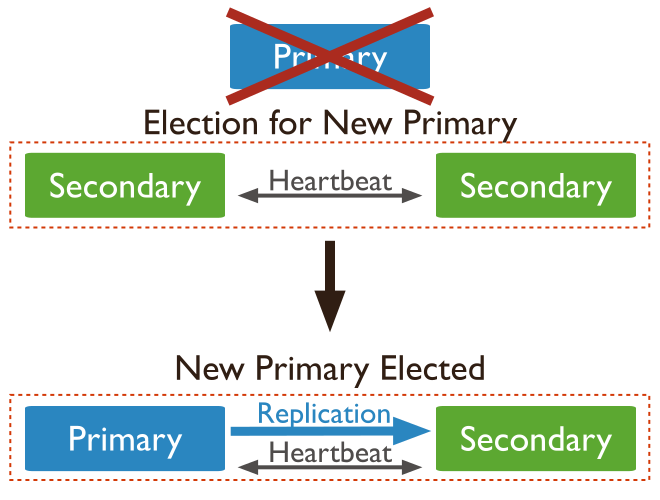You are looking at the documentation of a prior release. To read the documentation of the latest release, please
visit here.
New to KubeDB? Please start here.
MongoDB Replication
A replica set in MongoDB is a group of mongod processes that maintain the same data set. Replica sets provide redundancy and high availability, and are the basis for all production deployments. This section introduces replication in MongoDB as well as the components and architecture of replica sets.
Redundancy and Data Availability
Replication provides redundancy and increases data availability. With multiple copies of data on different database servers, replication provides a level of fault tolerance against the loss of a single database server.
ReplicaSet Members
Replica set contains several data bearing nodes and optionally one arbiter node. Of the data bearing nodes, one and only one member is deemed the primary node, while the other nodes are deemed secondary nodes.
The members of a replica set are primary and secondaries. You can also maintain an arbiter as part of a replica set. Arbiters do not keep a copy of the data. However, arbiters play a role in the elections that select a primary if the current primary is unavailable.
The minimum recommended configuration for a replica set is a three member replica set with three data-bearing members: one primary and two secondary members. You may alternatively deploy a three member replica set with two data-bearing members: a primary, a secondary, and an arbiter, but replica sets with at least three data-bearing members offer better redundancy.
A replica set can have up to 50 members but only 7 voting members.
Primary
The primary is the only member in the replica set that receives write operations. MongoDB applies write operations on the primary and then records the operations on the primary’s oplog. Secondary members replicate this log and apply the operations to their data sets.
In the following three-member replica set, the primary accepts all write operations. Then the secondaries replicate the oplog to apply to their data sets.

All members of the replica set can accept read operations. However, by default, an application directs its read operations to the primary member.
The replica set can have at most one primary. If the current primary becomes unavailable, an election determines the new primary. See Replica Set Elections for more details.
Secondaries
A secondary maintains a copy of the primary’s data set. To replicate data, a secondary applies operations from the primary’s oplog to its own data set in an asynchronous process. A replica set can have one or more secondaries.
The following three-member replica set has two secondary members. The secondaries replicate the primary’s oplog and apply the operations to their data sets.

Although clients cannot write data to secondaries, clients can read data from secondary members. See Read Preference for more information on how clients direct read operations to replica sets.
A secondary can become a primary. If the current primary becomes unavailable, the replica set holds an election to choose which of the secondaries becomes the new primary.
Arbiter
An arbiter does not have a copy of data set and cannot become a primary. Replica sets may have arbiters to add a vote in elections for primary. Arbiters always have exactly 1 election vote, and thus allow replica sets to have an uneven number of voting members without the overhead of an additional member that replicates data.
Changed in version 3.6: Starting in MongoDB 3.6, arbiters have priority 0. When you update a replica set to MongoDB 3.6, if the existing configuration has an arbiter with priority 1, MongoDB 3.6 reconfigures the arbiter to have priority 0.
IMPORTANT: Do not run an arbiter on systems that also host the primary or the secondary members of the replica set. [reference].
Asynchronous Replication
Secondaries apply operations from the primary asynchronously. By applying operations after the primary, sets can continue to function despite the failure of one or more members.
Automatic Failover
When a primary does not communicate with the other members of the set for more than the configured electionTimeoutMillis period (10 seconds by default), an eligible secondary calls for an election to nominate itself as the new primary. The cluster attempts to complete the election of a new primary and resume normal operations.

The replica set cannot process write operations until the election completes successfully. The replica set can continue to serve read queries if such queries are configured to run on secondaries while the primary is offline.
The median time before a cluster elects a new primary should not typically exceed 12 seconds, assuming default replica configuration settings. This includes time required to mark the primary as unavailable and call and complete an election. You can tune this time period by modifying the settings.electionTimeoutMillis replication configuration option. Factors such as network latency may extend the time required for replica set elections to complete, which in turn affects the amount of time your cluster may operate without a primary. These factors are dependent on your particular cluster architecture.
Lowering the electionTimeoutMillis replication configuration option from the default 10000 (10 seconds) can result in faster detection of primary failure. However, the cluster may call elections more frequently due to factors such as temporary network latency even if the primary is otherwise healthy. This can result in increased rollbacks for w : 1 write operations.
Your application connection logic should include tolerance for automatic failovers and the subsequent elections.
Read Operations
By default, clients read from the primary; however, clients can specify a read preference to send read operations to secondaries. Asynchronous replication to secondaries means that reads from secondaries may return data that does not reflect the state of the data on the primary. For information on reading from replica sets, see Read Preference.
Multi-document transactions that contain read operations must use read preference primary.
All operations in a given transaction must route to the same member.
Transactions
Starting in MongoDB 4.0, multi-document transactions are available for replica sets.
Multi-document transactions that contain read operations must use read preference primary.
All operations in a given transaction must route to the same member.
Change Streams
Starting in MongoDB 3.6, change streams are available for replica sets and sharded clusters. Change streams allow applications to access real-time data changes without the complexity and risk of tailing the oplog. Applications can use change streams to subscribe to all data changes on a collection or collections.
Next Steps
- Deploy MongoDB ReplicaSet using KubeDB.
- Detail concepts of MongoDB object.
- Detail concepts of MongoDBVersion object.
- Want to hack on KubeDB? Check our contribution guidelines.
NB: The images in this page are taken from MongoDB website.



































